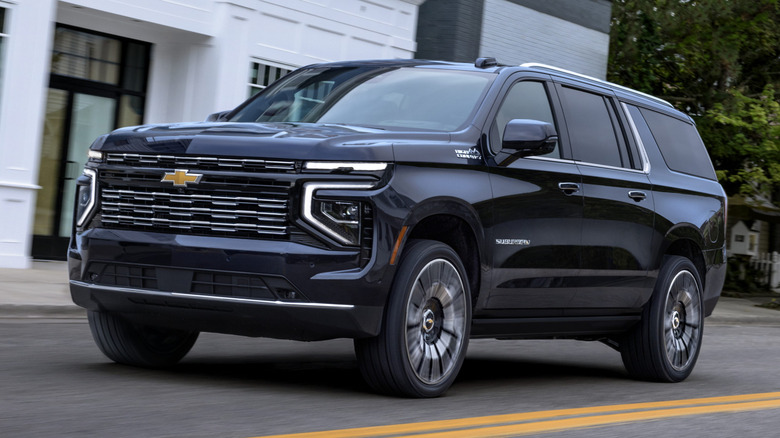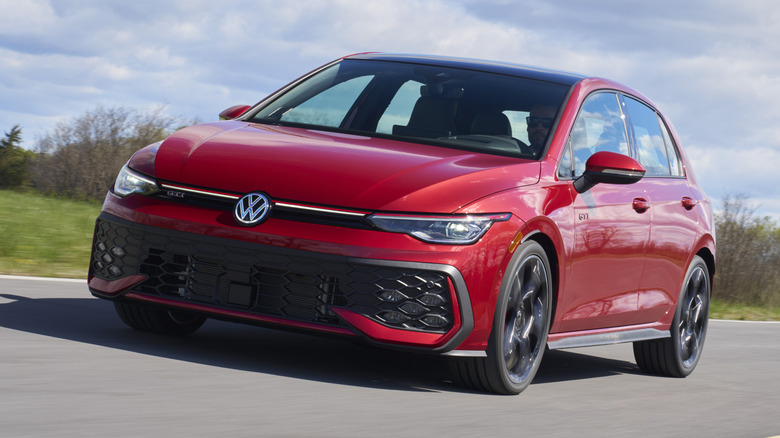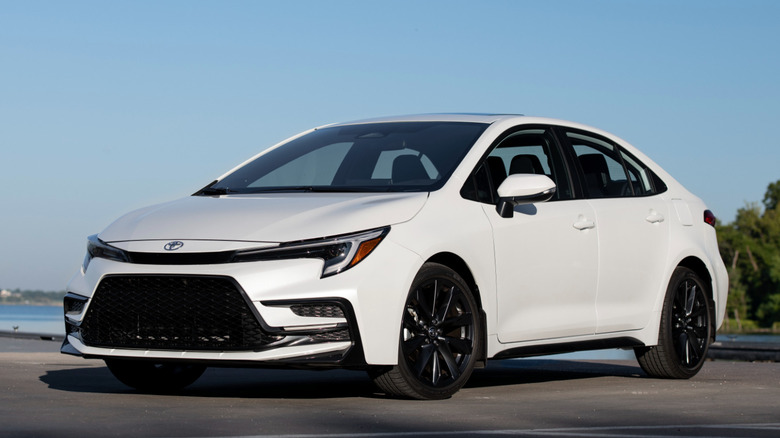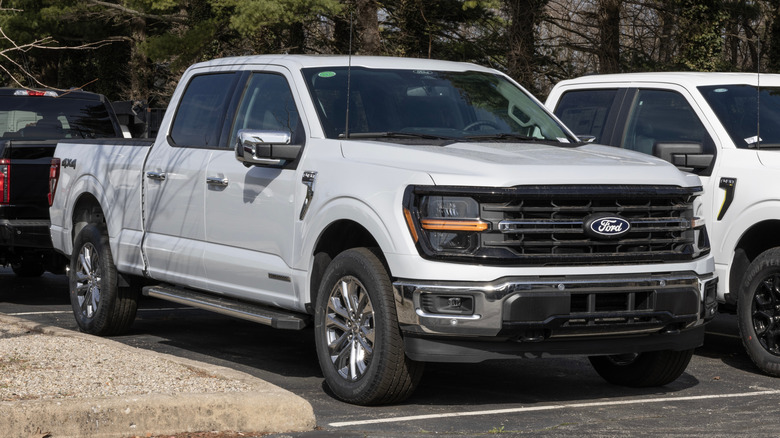13 Of The Longest Running Nameplates In Automotive History, Ranked Newest To Oldest
Changing buyer tastes dictate that manufacturers offer an ever-evolving range of models in their dealerships, but some models stick around longer than others. Some end up surviving generations, receiving styling, powertrain, and tech updates without ever losing the core appeal that made them a hit with buyers in the first place. Over time, their nameplates become an increasingly important part of their maker's history, and today, most of the longest-running nameplates couldn't be axed without a significant pushback.
Some brands do end up axing historic nameplates as buyer demand decreases — to take just one example, the iconic Volkswagen Beetle was in production for 74 years before being discontinued in 2019 — but many still survive. We've rounded up 13 of the longest-running nameplates in automotive history, all of which can still be bought new in the U.S. at the time of writing.
Volkswagen Golf — since 1974
Undoubtedly one of Giorgetto Giugiaro's best car designs, the original Volkswagen Golf set the template for what a front-wheel drive hatchback should look like. It launched in 1974, with the Golf nameplate being used in all markets aside from the U.S., where it was initially marketed as the Rabbit. By the end of the decade, Volkswagen had set up a plant in the U.S. and produced Rabbits that were tweaked specifically for American tastes. A second-generation Golf arrived in the mid-'80s that kept much of the fundamental styling but was larger and more efficient.
The third generation of the Golf was launched in 1991, hitting U.S. dealerships as a 1993 model year car. It was relatively short-lived, and by the end of the '90s, it had been replaced by the fourth-generation model. New generations followed every few years, with the most recent eighth-generation being unveiled in 2019.
Volkswagen also launched a similarly long-lived model that Americans never got. The Polo slotted in below the Golf, being smaller and more affordable but with a similar focus on practicality. It arrived in 1975, the year after the Golf, and remains on sale in Europe today, having celebrated its 50th anniversary in 2025.
BMW 5-Series — since 1972
The latest generation of the BMW 5-Series arrived with a slew of changes from the outgoing model, with an all-electric variant offered alongside the traditional gas-powered versions of the sedan. Its styling is also revised, with a new interpretation of BMW's oversized kidney grille and a new infotainment system taking center stage in the cabin. It's the latest in a long line of 5-Series models that stretches back to 1972, where the model replaced the "New Range" or "Neue Klasse" that had helped revive its fortunes in the '60s.
The first generation of the car was produced until 1982, when a second generation arrived sporting a new optional diesel engine. The third generation was launched in 1988 and brought with it a new wagon body style, the 5-Series Touring. Many revisions followed, and the latest generation's biggest change is the introduction of the i5 EV. Sedans might not be as popular as they once were, but the 5-Series remains a core part of BMW's lineup, and continues to evolve with each new generation of the car.
Mercedes-Benz S-Class — since 1972
Although Mercedes-Benz has produced flagship luxury sedans since its post-war revival, the S-Class nameplate wasn't introduced until 1972. The first S-Class pioneered a number of systems that modern car drivers take for granted, like anti-lock brakes (ABS) and cruise control. It was also the first production car to feature a turbodiesel engine under the hood.
Its replacement arrived for the turn of the decade, and would remain in production for 12 years until 1992. It also offered plenty of in-car tech, such as an electronically adjustable steering column and driver and passenger airbags.
The latest generation of the car debuted in 2020 and offers the same blend of tech and luxury that buyers expect. However, it doesn't come cheap, with even the entry-level variant of the 2025 model costing $118,900 (including a $1,150 destination charge). Buyers looking to get themselves a top-spec Maybach S-Class can expect to pay around a quarter of a million dollars, depending on what options they pick.
Honda Civic — since 1972
The Honda Civic arrived at a period when the company was under serious strain. Its previous models were selling very badly and the firm's balance sheet was in such dire straits that internal rumors suggested that Honda might exit the business of producing cars if it couldn't rescue its image. The Civic was designed to be completely different from Honda's previous models, focusing on value and clever design, even though some executives at the company weren't convinced that such a car could be profitable.
As it turns out, the executives' fears proved unfounded, and the Civic was a hit in Japan virtually as soon as the first example rolled off the production line in 1972. It became a hit in export markets like the U.S., too, in part thanks to buyers' preferences for smaller, more efficient cars in the wake of the 1973 oil crisis. The car has remained in production ever since, and is now in its 11th generation. The Civic is available as a sedan and remains available as a hatchback, which can now be optioned with a hybrid powertrain for a further efficiency boost.
Toyota Corolla — since 1966
Honda isn't the only Japanese manufacturer to boast a long-running nameplate among its current roster. Toyota has an even older model, the Corolla, which launched in 1966. Much like the Honda Civic, a key part of the Corolla's longevity is strong sales in both domestic and international markets. In fact, it has become so successful that it's considered the world's best-selling car, with over 50 million examples sold since its launch.
Toyota continues to offer the Corolla as an affordably priced economy car, but there's also a rally-derived hot hatch edition available with a manual transmission. For 2025, we gave the Toyota GR Corolla a 10/10 rating, noting that a surprisingly efficient powertrain and inherent hatchback practicality complement its all-terrain performance chops. That powertrain helps the GR Corolla become an even more tempting proposition for a fun daily driver, although it doesn't come cheap. Our test vehicle clocked in at almost $50,000, although base spec examples start from just over $40,000.
Ford Mustang — since 1964
Ford has a strange conundrum on its hands with the Mustang. The 2025 Mustang can still be bought with a V8 engine under the hood and a manual transmission, and in base spec form, it's also attainably priced. Plenty of commentary online suggests that this is exactly the kind of car that enthusiasts want, yet the Mustang isn't selling. In 2024, Ford only sold around 37,000 examples of the car, and its annual sales figures have been declining for around a decade now. For context, Ford sold over 122,000 examples of the Mustang in 2015.
For now, Ford remains committed to keeping the Mustang in its traditional form, although with the introduction of the Mustang Mach-E, it showed that it wasn't afraid to use the nameplate in new segments. Despite the controversy at its launch, the Mustang Mach-E has proved a popular EV model, and actually outsold the gas-powered Mustang by roughly 10,000 units in 2024.
The same year, Ford celebrated 60 years of the Mustang nameplate, which shaped the pony car segment when it launched in 1964. In its first year on sale, Ford sold 418,000 examples of the Mustang, and has sold more than 10 million examples in the years since. How much longer the Mustang survives in traditional pony car form remains to be seen, but it will no doubt depend on how many buyers remain willing to cough up the cash for one.
Porsche 911 — since 1963
The modern Porsche 911 is an automotive oddity in that it's the only sports car from a major brand to feature a rear-engine layout, a design that's been carried over since the car's launch in 1963. The car's styling has also stayed remarkably similar throughout its six-plus decades of production, with the 996 being the most visibly different thanks to its infamous "fried egg" headlights. The original 911 of 1963 produced 128 horsepower from its 2.0L six-cylinder engine, although that figure was bumped up to 207 horsepower over the course of the first generation's production run.
The second generation of the 911 was launched in 1973, followed by further iterations in 1989, 1994, and 1998. It was this 1998 model, the 996 generation 911, that ditched the car's traditional air-cooled engine for a water-cooled one. The 996 angered some purists, but its success, alongside that of the related, entry-level Boxster, sold well enough to save Porsche from bankruptcy. Later generations of the 911 have reverted closer to the styling of the original, with the current 992 generation of the car first launching in 2019.
Toyota Crown — since 1955
It might have only been available in the U.S. for a small proportion of its production lifespan, but the Toyota Crown nameplate is an icon in its home country. The first Crown was launched in 1955 and was designed to be both more comfortable and more capable than Toyota's previous models.
It was built with Japan's patchy road infrastructure in mind, and so featured a unique suspension design to deal with rough road surfaces. Toyota was convinced that the Crown's talents would also appeal to export markets, and it launched the model in the U.S. in 1957. However, the car's small, modestly powered engine didn't catch on with American buyers.
As a result, Toyota focused its efforts on developing the Crown for the Japanese market, where it quickly became popular. Over the decades, it evolved into an upmarket sedan and, even after it was taken off sale in export markets, it remained in production in Japan. In 2025, the nameplate hit 70 years old, which Toyota marked by launching a new version of the Crown, named the Crown Estate, in Japan. American buyers have a choice of two Crown models to pick from today, either the Crown sedan or the Crown Signia SUV.
Mercedes-Benz SL — since 1954
Aside from being one of the best looking Mercedes-Benz models ever designed, the 300 SL Gullwing also marked the start of one of the longest-running nameplates in automotive history. The racing version of the 300 SL debuted in 1952 and quickly gained international attention by winning multiple prestigious races, including the 24 Hours of Le Mans.
Seeing its success, Max Hoffman, the American importer of Mercedes-Benz, pushed to get a road-going version of the car developed. After some persuasion, the automaker obliged and developed a sports car that launched in 1954. Thanks to its upwards-opening doors, it quickly became known as the Gullwing.
Mercedes-Benz initially offered the SL as a coupe and a convertible, but over later generations, the SL became best recognized in drop-top form. From the "Pagoda" SL of the '60s to the high-tech R129 of the '90s, the SL continued to combine luxury with increasingly high power outputs. The top-spec 2025 AMG SL 63 S E Performance Roadster is the latest and greatest in that long line of models, with over 800 horsepower on tap from its hybrid V8 powertrain and a starting price north of $200,000. For 2025, the brand has also launched the exclusive Mercedes-AMG SL 63 MANUFAKTUR Golden Coast, which sports a unique gold paint color and is limited to 100 examples.
Toyota Land Cruiser — since 1954
Like many off-road vehicles, the Toyota Land Cruiser can trace its roots back to military usage. The original Land Cruiser was designed to be a domestically built version of the Willys Jeep, with the initial prototypes being offered to the Japanese Police in 1951. While the police didn't order production versions of Toyota's Jeep design, the automaker saw potential for a customer version of the vehicle and kept refining the design. Eventually, Toyota secured orders from several other government departments, and production began in 1953.
During its first year on sale, the car was known as the Toyota Jeep, but thanks to a trademark complaint from Willys, Toyota changed the name to the Land Cruiser in 1954. The car has remained a staple of Toyota's lineup ever since, with its reputation for durability and all-terrain capability making it the vehicle of choice for drivers in remote areas around the world.
Toyota doesn't sell the latest 300 Series Land Cruiser in America, but it instead sells a vehicle that's sold in other markets at the Land Cruiser Prado. Both new and used examples of the Land Cruiser continue to be popular with buyers, with many older examples commanding high prices thanks to their reputation as workhorses.
Chevrolet Corvette — since 1953
The latest generation of the Chevrolet Corvette is a mid-engined supercar killer, but for most of its existence, the Corvette was a front-engined sports car. It first launched in 1953 and evolved through the muscle car era and the malaise years, changing its appearance — and its power output — but remaining one of the quintessential American sports cars. Although it still features a V8 engine under the hood, the latest generation of the car also offers a hybrid powertrain.
The Corvette E-Ray was launched in time to celebrate the 70th anniversary of the nameplate and offers 655 combined horsepower and a 0-60 mph time of just 2.5 seconds. It also offers all-wheel drive, another major change from the Corvette's historically rear-wheel drive layout. It might be a very different beast to its predecessors, but the latest Corvette still does what the previous generations did — offer an all-American alternative to European exotica while undercutting those foreign rivals in price.
Ford F-Series — since 1948
Ford's immensely popular F-Series trucks have been in production since 1948. They're so popular, in fact, that the F-Series was America's best-selling truck for almost five decades. The modern F-Series lineup includes the F-150, F-250, F-350, F-450, and F-600, with Ford grouping those models for sales data purposes. As such, there's no way to tell exactly how many of each of those models Ford sells per year, and one report caused controversy in early 2025 by suggesting that the F-150 had been overtaken as America's best-selling vehicle by the Toyota RAV4.
Ford disputes the notion that the F-150 is no longer America's favorite, but however you choose to look at the sales numbers, it's safe to say that Americans remain infatuated with the pickup. That infatuation has continued throughout the F-150's fourteen generations, and there's no sign of its popularity waning anytime soon.
Chevrolet Suburban — since 1935
When it comes to nameplate longevity, nothing matches the Chevrolet Suburban. It's been in production since 1935 and has remained a top choice for buyers looking to haul families and their luggage ever since then. Every generation of the Chevrolet Suburban has stayed true to the same basic formula, although naturally, the car has seen plenty of changes. The first generation car featured a 3.4L six-cylinder engine under the hood, with Chevy not adding a V8 until the arrival of the fourth generation in 1955.
The current Chevrolet Suburban still packs a V8 under the hood, and as a result, it's far from frugal. However, it's still spacious, well-equipped, and powerful enough to tow up to 8,200 pounds. Unfortunately for buyers on tighter budgets, the Suburban is also costly, with the price for the 2025 model starting at $64,195 (including a $2,195 destination fee) and stretching past the $90,000 mark for a fully-loaded top-spec example.
How we compiled this list of long-running car nameplates
Each of the cars here has been in continuous production since its launch, although not every car has always been available in the U.S. over that period. Some, like the Toyota Crown, have only been available in the U.S. for a small minority of their total production lifespan. However, all of the cars remain available to buy in the U.S. as 2025 or 2026 model year cars at the time of writing.
The listed year of introduction for each nameplate refers to the first year that the model was sold officially with that nameplate, according to the manufacturer. Some of the nameplates listed here were launched in Europe or Japan before coming to America — for comparative purposes, we've used the dates that the nameplate was first launched in its original market, rather than the dates that each one first arrived in the U.S. market.














